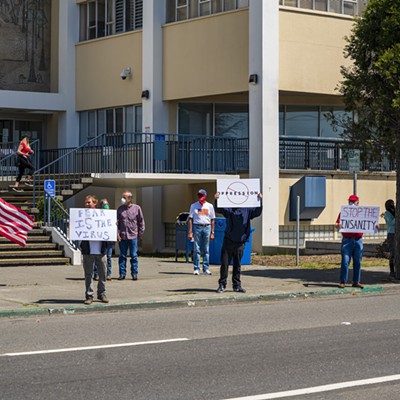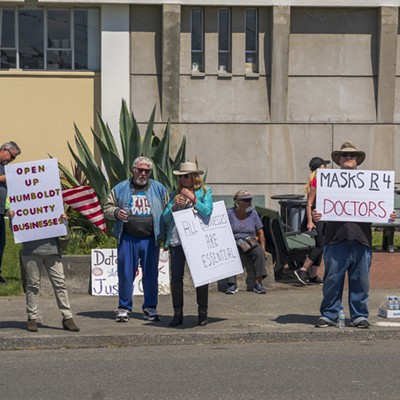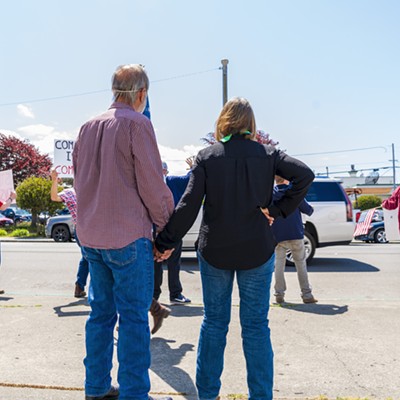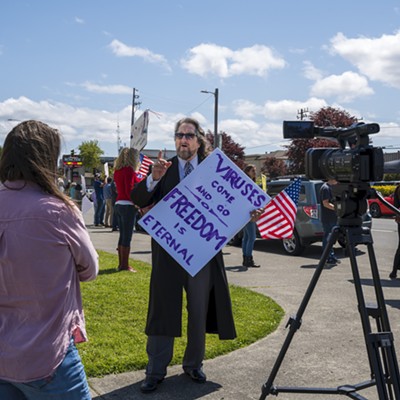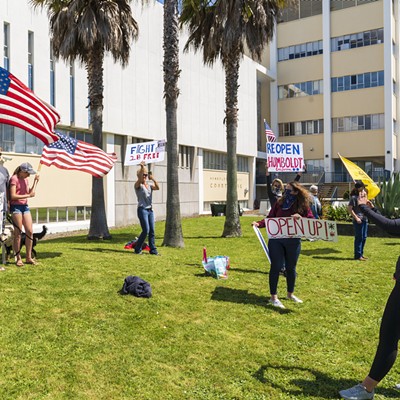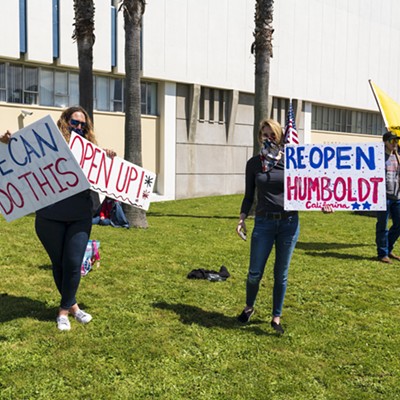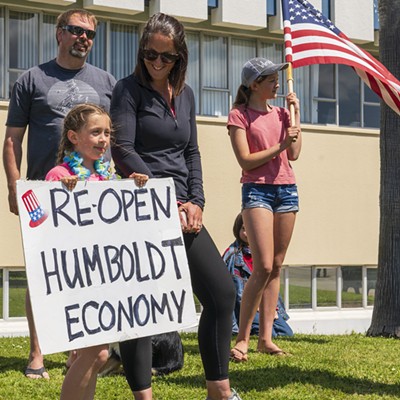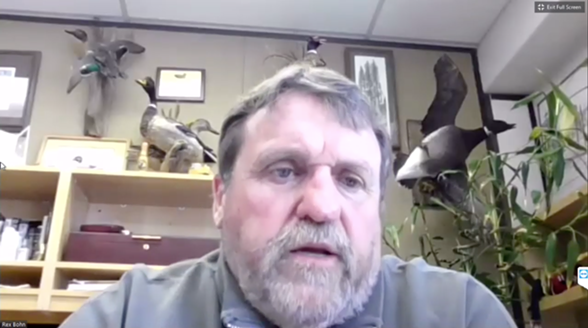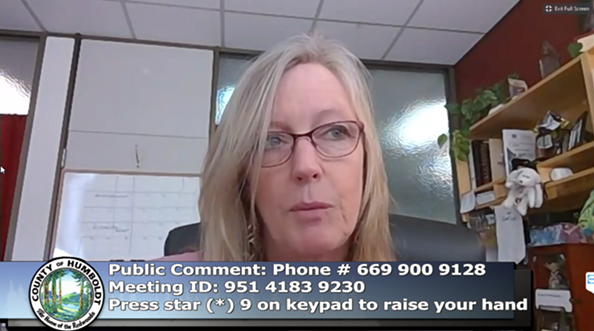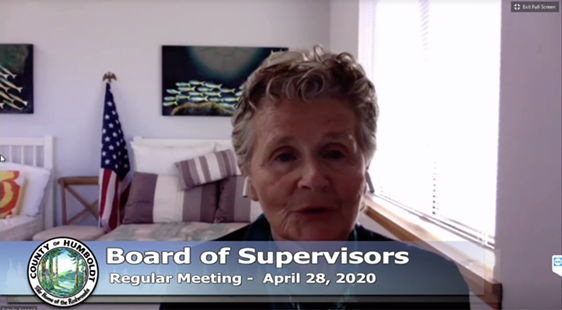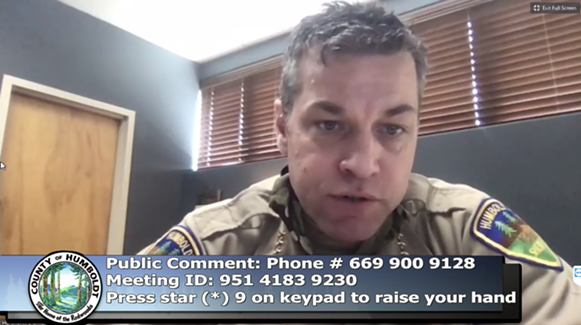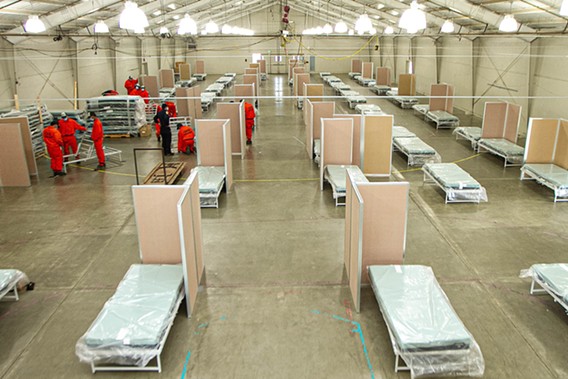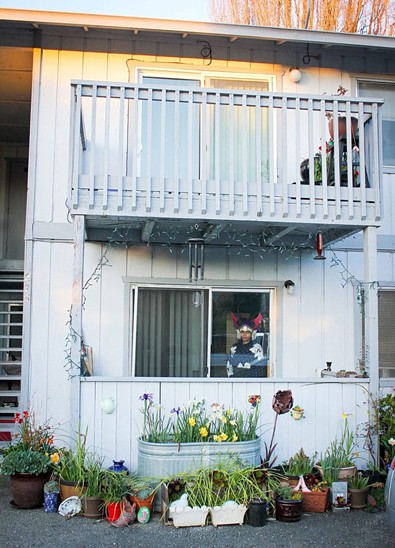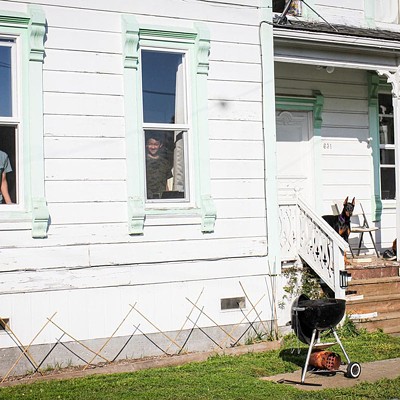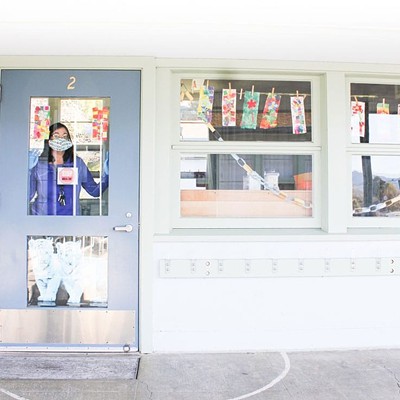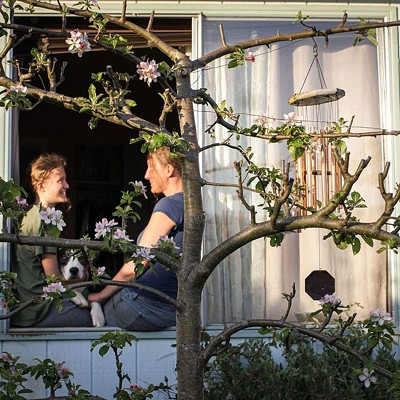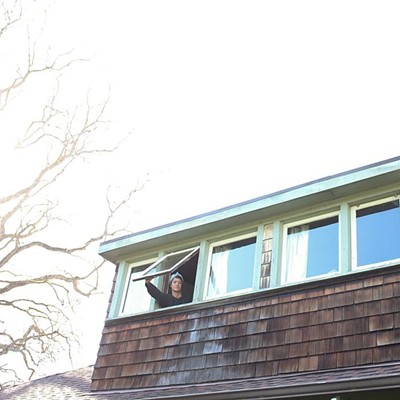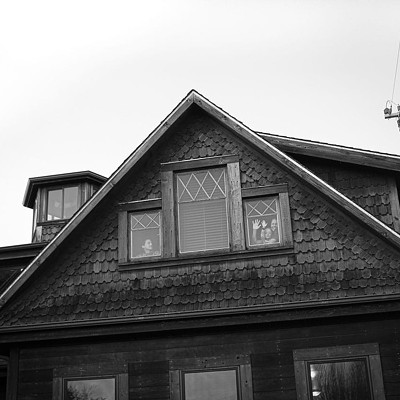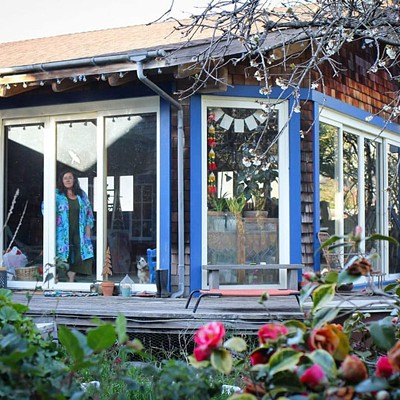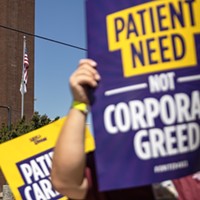Sunday, May 3, 2020
‘This is What a Pandemic Does:’ Humboldt Begins Charting a Course out of Shelter in Place
Posted By Thadeus Greenson @ThadeusGreenson on Sun, May 3, 2020 at 9:01 AM
It was about an hour and a half into an April 28 COVID-19 briefing before the Board of Supervisors, amid a discussion that was pressing at times, with a pair of seemingly frustrated supervisors inquiring why certain businesses hadn’t been allowed to open or why Humboldt wasn’t being treated differently than other areas of the state, when Chair Estelle Fennell asked Public Health Director Michelle Stephens if she had anything to add.
Stephens then took the proverbial dais at the virtual meeting, which saw all participants video conferencing in from their homes or offices.
“A couple of things come to mind,” Stephens began. “We all have friends … that have small businesses that are severely impacted by this. I worry for them and I worry for their families. This is what a pandemic does to a country, a world, a community, and we’re in the middle of it. … When we reopen, we will have an increase in cases.”
Stephens essentially backed Newsom’s plan to keep the entire state sheltering in place for some weeks longer, giving counties the chance increase testing capacities and stockpiles of personal protective equipment for first responders and healthcare workers so there aren’t shortages when case counts rise. Plus, counties and businesses need time to plan for safe re-openings, recognizing life will not return to normal for months or years.
“I just want to say that it’s a difficult time,” she continued. “There’s tension everywhere around the pressure to open because people are hurting financially. It’s very real for people and we get that. And we also have a virus that is killing people and that could really overwhelm our rural community very easily. And so we’ve been doing tons of preparing for that, which is exactly what public health is about.”
Stephens’ comments highlighted the frustrations and pressures that underscore the conversation, both on social media and in the supervisors now virtual chamber, as the county plans to ease some restrictions. Three days later, roughly 50 people stood in front of the Humboldt County Courthouse, some wearing facial coverings made mandatory by a recent health order and many not, protesting the shelter-in-place order and urging a full reopening of the local economy. They wore American flags and held homemade signs with slogans like, “Fear is the virus,” “Tyranny: spreading faster than COVID-19,” “Crisis does not excuse communism” and simply “Open now.”
Beyond the protest, there were more tangible signs this past week that the shelter in place order is having impacts beyond slowing the virus’ spread, with a case count that has hovered in the low 50s for weeks after doubling in a six-day period in early April. Humboldt County Economic Development Director Scott Adair reported that the local area saw 5,846 local unemployment claims in March alone, business owners reported to a county survey they’d lost $30.2 million in revenue and let go 2,400 employees. A planned four-hour food box distribution in Hoopa closed after just 45 minutes when supplies were depleted. In a county in which 20 percent of people lived in poverty and 40 percent of households reported food insecurity before shelter in place, food banks are reporting unprecedented demand.
The county and its 57 counterparts remain legally bound under Gov. Gavin Newsom’s shelter-in-place order until he decides otherwise. This week, Newsom outlined a broad four-stage plan for re-opening the state. We’re in the first stage, with the entire state sheltering in place and only “essential” businesses allowed to operate as the state and counties work to increase capacity for hospital surge and contract tracing investigation, while stockpiling testing supplies and personal protective equipment. The entire state will remain in this first stage, Newsom has said, until statewide hospitalization and intensive care trends stabilize, and the state is prepared to ideally prevent — or at least handle — a large surge in cases.
“The idea is we do that as one,” said Humboldt County Public Health Officer Teresa Frankovich at the supervisors meeting.
That idea has proven unpopular in some circles, and officials in Modoc, Mendocino, Yuba and Sutter counties have been openly defiant of the governor's plan. On social media, First District Supervisor Rex Bohn has repeatedly questioned the wisdom of treating California uniformly when it spans 160,000 square miles, some of it urban and much of it rural.
“It seems like we’re not going to do anything until all 58 counties do it in unison and we’re not a one-size-fits-all location,” he said at the meeting, adding that it’s easier to social distance in Humboldt County, where public transit isn’t overrun with people. “Are we looking to bend back a little bit on that one size fits all?”
Frankovich said there has been some “pretty animated discussion” about this between county health officers and the state but indicated she supports this aspect of the governor’s plan.
“There’s some merit there in that viruses obviously don’t recognize borders and we know the areas that get hard hit can impact us, as well,” she said. “I think there is an argument there for having an all-ready-to-respond [approach], then move regionally.”
The fact of the matter, Frankovich said, is that when COVID-19 hit, “we weren’t prepared.” This initial stage of sheltering in place is about getting ready, she said, and while that means governments working to bolster testing and capacity, it also means business owners figuring out how they can operate safely — practicing social distancing, disinfecting surfaces, making sure employees are masked and washing hands — moving forward in what will ultimately be a long road back to normal.
At one point, Frankovich said this isn’t a process that will take months but a couple years. Bohn responded that she was “literally freaking out the masses” by referencing a two-year timeline.
But that’s the reality, Frankovich said. This current stage may only last days or weeks, but then the second stage will see a very scaled re-opening of some businesses based not on how “essential” or “important” they are, but how safely they can operate. This might mean retail stores offering curbside pickup, some manufacturers re-starting production and some offices re-opening where telecommuting is infeasible. But all this should be based on which business and entities can re-open with plans in place that maximize social distancing and sanitation, minimizing risk to employees and the community.
Stage three would include a broader re-opening of businesses — the governor’s plan includes hair and nail salons, gyms, movie theaters and in-person religious services in this group. The final stage, which Frankovich said will likely be contingent on having a vaccine for the virus, will see the return of mass events like concerts and sporting events in front of stadiums full of people.
“Two years sounds really scary to people but it’s not going to be two years of looking like this,” she said, adding that it will be a gradual return.
And Frankovich stressed she thinks there will be local control when navigating how to re-open businesses and how Humboldt County generally moves through stages two and three after the governor makes the statewide call to move out of stage one.
Fourth District Supervisor Virginia Bass then asked about personal care salons and why they’re lumped into the third stage of re-opening as outlined by the governor. “There are creative local business owners who could put plans in place to protect their customers and employees,” she said, asking, “Do you see any wiggle room in that kind of situation?”
Frankovich reiterated that the intent is to reopen businesses based on risk factors — whether customers and employees can socially distance and wear masks, whether surfaces can be regularly disinfected and if there are hand washing stations. An issue will be making sure everyone can keep 6 feet apart from the moment they enter an establishment to the moment they leave.
But if the bar is 6 feet, that’s “a real hard requirement,” Bass said, adding, “unless you have big sticks you use to hand people food,” restaurants can’t meet that requirement now for take-out services, though they’re allowed to continue operations. Frankovich said she thinks the distinction there is the combination of distance and length of proximity, noting that getting your hair or nails done necessitates “prolonged, intimate contact.”
Bohn then asked whether there could be separate sets of rules for those statistically most vulnerable to the virus — seniors and people with underlying illnesses or compromised immune systems — and younger, healthier people.
“There’s a lot of healthy people out there that can interact a little bit more via haircuts,” he noted.
Frankovich said “the answer to that” is that Public Health will be pushing for those vulnerable to isolate and avoid social contacts as much as possible until there’s a vaccine or “some darn good therapeutics” that have proven very effective in treating the disease. Fennell then chimed in to note that there are some healthy people who have gotten “very, very sick” from the virus, saying everyone “wants to get back to normal but we don’t want to gamble with people’s lives.”
But how to protect those statistically most vulnerable — and indications are Humboldt County has a disproportionate number, as more of our population is 65 and over, suffers from heart disease, diabetes and strokes than the rest of the state — is also very much a part of current preparation efforts. Deputy Health Officer Josh Ennis said the county has put some systems in place to support people who have been ordered to isolate or quarantine because they’ve had the virus or were awaiting test results, including bringing them food and medications. The county is now looking at how these systems might be “built out” to help keep seniors at home longer term.
But that’s just one aspect of ongoing preparation. Frankovich explained that a mobile testing facility — the first set up by the state — is still working to build up capacity and fine tune operations before it can be opened to the general public. And Ennis said alternative care sites — one being built out at Redwood Acres Fairgrounds and another adjacent to Mad River Community Hospital — are still gathering supplies and readying for a potential surge, while the hospitals themselves are planning to maximize the number of patients they can treat and expand intensive care capacity. Overall, he said, plans are in place that would triple the number of intensive care beds in the county if needed, adding that the county currently has 46 ventilators, about 20 more than it did a month ago.
But the larger question Ennis and Public Health are scrambling to figure out is: If all those beds are needed, who is going to staff them?
“Our workforce is probably the most critical component of this and likely where we’re to experience the most significant limitations,” Ennis said. “There’s been a lot of discussion with hospitals and other healthcare entities out in the community about what this could look like.”
The focus, Ennis said, is on the various skillsets people have, realizing if the surge comes, it will necessitate an all-hands-on-deck approach. That could mean using anesthesiologists and surgeons to work in intensive care units, relying on tele-health were possible and potentially even recruiting “people out in the community comfortable enough with in-patient medicine to contribute to the workforce” at the alternate care sites. Reinforcements could come from the state, Ennis said, though he added officials would like to “see this happen locally as much as possible.”
The county, meanwhile, is also asking businesses to prepare to reopen in ways that will minimize risk. It circulated a survey last week seeking input from residents about which businesses they would like to see reopen first. Sheriff William Honsal said the county is also seeking input from cities and chambers of commerce, and will take all that input into account when charting a path forward. It’s unclear exactly what that course will look like, whether the county will be signing off on individual businesses’ safety plans, giving businesses the autonomy to decide whether they can reopen safely or some combination thereof.
As the discussion in the supervisors meeting drew to a close, Third District supervisor Mike Wilson chimed in, saying in addition to figuring out how portions of the business community can re-open, the county should be looking at ways to create more open spaces for children to recreate, potentially closing some residential streets to through traffic.
“We’ve spent a bunch of time talking about making open spaces available for people who can pay for them,” Wilson said, referencing a lengthy back and forth about whether golf courses should re-open (they since have with restrictions). “There needs to be some equity.”
Wilson also said while some are loudly urging re-opening, it’s important to note that he’s had “plenty of constituents” call in to say they’re concerned about reopening too quickly.
As shelter in place enters its seventh week, it’s clear frustrations are mounting, as is pressure on all involved. But what officials have repeatedly stressed is that so is preparation, as virtually all aspects of local government work to ready for the next phase.
During the meeting, Frankovich stressed she fears that reopening too quickly and without proper plans and protections in place could lead to another bout of shelter in place, which nobody wants.
“If we can sort of look at this more science-based approach and (exercise) some patience on the front end, I think we can help to minimize some of the economic and health impacts long term,” she said. “I know it’s been rough.”
And at this point, anyway, the only alternative is willfully violating the governor’s order, thumbing Humboldt County’s nose at the state that has delivered a mobile testing site, shipments of personal protective supplies and the equipment needed to transform Redwood Acres into a care site.
“To go behind the governor and violate his order and do our own changes might burn us later when we need them,” Stephens cautioned.
Just a couple days later, Honsal publicly stood up to the governor after word leaked Newsom intended to order all beaches in the state closed after Orange County residents flooded their beaches last weekend with minimal social distancing. Honsal issued a fiery statement announcing his “strong opposition” to the potential order and hinting that he would deem it “unconstitutional” and opt not to enforce it. A short time later, Newsom’s office announced that it had limited the order to Southern California, prompting Honsal to express his gratitude.
The back and forth helps illustrate the delicate dance taking place as officials weigh statewide preparedness against local needs, preparation against urgency, protection against risk, and economic damage and all that comes with it against the spread of a deadly virus. Amid it all, there’s a vocal contingent who simply don’t believe the risk is what the vast majority of the world’s epidemiologists, physicians and public health officials say it is.
“Sometimes people don’t want to hear what’s being said and so they’re going to go shop for something else to try and provide an argument [against] what we’re doing here. And I get that. Trust but verify, right?” Honsal said into his webcam at the supervisors’ meeting. “But the fact is, we have to go with the facts. Dr. Frankovich and I are dedicated here to doing what is best for our community. And we understand these are harsh decisions at times but these are decisions we make for our county, for our people, in the best interest of public health at this time.”
Stephens then took the proverbial dais at the virtual meeting, which saw all participants video conferencing in from their homes or offices.
“A couple of things come to mind,” Stephens began. “We all have friends … that have small businesses that are severely impacted by this. I worry for them and I worry for their families. This is what a pandemic does to a country, a world, a community, and we’re in the middle of it. … When we reopen, we will have an increase in cases.”
Stephens essentially backed Newsom’s plan to keep the entire state sheltering in place for some weeks longer, giving counties the chance increase testing capacities and stockpiles of personal protective equipment for first responders and healthcare workers so there aren’t shortages when case counts rise. Plus, counties and businesses need time to plan for safe re-openings, recognizing life will not return to normal for months or years.
“I just want to say that it’s a difficult time,” she continued. “There’s tension everywhere around the pressure to open because people are hurting financially. It’s very real for people and we get that. And we also have a virus that is killing people and that could really overwhelm our rural community very easily. And so we’ve been doing tons of preparing for that, which is exactly what public health is about.”
Stephens’ comments highlighted the frustrations and pressures that underscore the conversation, both on social media and in the supervisors now virtual chamber, as the county plans to ease some restrictions. Three days later, roughly 50 people stood in front of the Humboldt County Courthouse, some wearing facial coverings made mandatory by a recent health order and many not, protesting the shelter-in-place order and urging a full reopening of the local economy. They wore American flags and held homemade signs with slogans like, “Fear is the virus,” “Tyranny: spreading faster than COVID-19,” “Crisis does not excuse communism” and simply “Open now.”
Beyond the protest, there were more tangible signs this past week that the shelter in place order is having impacts beyond slowing the virus’ spread, with a case count that has hovered in the low 50s for weeks after doubling in a six-day period in early April. Humboldt County Economic Development Director Scott Adair reported that the local area saw 5,846 local unemployment claims in March alone, business owners reported to a county survey they’d lost $30.2 million in revenue and let go 2,400 employees. A planned four-hour food box distribution in Hoopa closed after just 45 minutes when supplies were depleted. In a county in which 20 percent of people lived in poverty and 40 percent of households reported food insecurity before shelter in place, food banks are reporting unprecedented demand.
The county and its 57 counterparts remain legally bound under Gov. Gavin Newsom’s shelter-in-place order until he decides otherwise. This week, Newsom outlined a broad four-stage plan for re-opening the state. We’re in the first stage, with the entire state sheltering in place and only “essential” businesses allowed to operate as the state and counties work to increase capacity for hospital surge and contract tracing investigation, while stockpiling testing supplies and personal protective equipment. The entire state will remain in this first stage, Newsom has said, until statewide hospitalization and intensive care trends stabilize, and the state is prepared to ideally prevent — or at least handle — a large surge in cases.
“The idea is we do that as one,” said Humboldt County Public Health Officer Teresa Frankovich at the supervisors meeting.
That idea has proven unpopular in some circles, and officials in Modoc, Mendocino, Yuba and Sutter counties have been openly defiant of the governor's plan. On social media, First District Supervisor Rex Bohn has repeatedly questioned the wisdom of treating California uniformly when it spans 160,000 square miles, some of it urban and much of it rural.
“It seems like we’re not going to do anything until all 58 counties do it in unison and we’re not a one-size-fits-all location,” he said at the meeting, adding that it’s easier to social distance in Humboldt County, where public transit isn’t overrun with people. “Are we looking to bend back a little bit on that one size fits all?”
Frankovich said there has been some “pretty animated discussion” about this between county health officers and the state but indicated she supports this aspect of the governor’s plan.
“There’s some merit there in that viruses obviously don’t recognize borders and we know the areas that get hard hit can impact us, as well,” she said. “I think there is an argument there for having an all-ready-to-respond [approach], then move regionally.”
The fact of the matter, Frankovich said, is that when COVID-19 hit, “we weren’t prepared.” This initial stage of sheltering in place is about getting ready, she said, and while that means governments working to bolster testing and capacity, it also means business owners figuring out how they can operate safely — practicing social distancing, disinfecting surfaces, making sure employees are masked and washing hands — moving forward in what will ultimately be a long road back to normal.
At one point, Frankovich said this isn’t a process that will take months but a couple years. Bohn responded that she was “literally freaking out the masses” by referencing a two-year timeline.
But that’s the reality, Frankovich said. This current stage may only last days or weeks, but then the second stage will see a very scaled re-opening of some businesses based not on how “essential” or “important” they are, but how safely they can operate. This might mean retail stores offering curbside pickup, some manufacturers re-starting production and some offices re-opening where telecommuting is infeasible. But all this should be based on which business and entities can re-open with plans in place that maximize social distancing and sanitation, minimizing risk to employees and the community.
Stage three would include a broader re-opening of businesses — the governor’s plan includes hair and nail salons, gyms, movie theaters and in-person religious services in this group. The final stage, which Frankovich said will likely be contingent on having a vaccine for the virus, will see the return of mass events like concerts and sporting events in front of stadiums full of people.
“Two years sounds really scary to people but it’s not going to be two years of looking like this,” she said, adding that it will be a gradual return.
And Frankovich stressed she thinks there will be local control when navigating how to re-open businesses and how Humboldt County generally moves through stages two and three after the governor makes the statewide call to move out of stage one.
Fourth District Supervisor Virginia Bass then asked about personal care salons and why they’re lumped into the third stage of re-opening as outlined by the governor. “There are creative local business owners who could put plans in place to protect their customers and employees,” she said, asking, “Do you see any wiggle room in that kind of situation?”
Frankovich reiterated that the intent is to reopen businesses based on risk factors — whether customers and employees can socially distance and wear masks, whether surfaces can be regularly disinfected and if there are hand washing stations. An issue will be making sure everyone can keep 6 feet apart from the moment they enter an establishment to the moment they leave.
But if the bar is 6 feet, that’s “a real hard requirement,” Bass said, adding, “unless you have big sticks you use to hand people food,” restaurants can’t meet that requirement now for take-out services, though they’re allowed to continue operations. Frankovich said she thinks the distinction there is the combination of distance and length of proximity, noting that getting your hair or nails done necessitates “prolonged, intimate contact.”
Bohn then asked whether there could be separate sets of rules for those statistically most vulnerable to the virus — seniors and people with underlying illnesses or compromised immune systems — and younger, healthier people.
“There’s a lot of healthy people out there that can interact a little bit more via haircuts,” he noted.
Frankovich said “the answer to that” is that Public Health will be pushing for those vulnerable to isolate and avoid social contacts as much as possible until there’s a vaccine or “some darn good therapeutics” that have proven very effective in treating the disease. Fennell then chimed in to note that there are some healthy people who have gotten “very, very sick” from the virus, saying everyone “wants to get back to normal but we don’t want to gamble with people’s lives.”
But how to protect those statistically most vulnerable — and indications are Humboldt County has a disproportionate number, as more of our population is 65 and over, suffers from heart disease, diabetes and strokes than the rest of the state — is also very much a part of current preparation efforts. Deputy Health Officer Josh Ennis said the county has put some systems in place to support people who have been ordered to isolate or quarantine because they’ve had the virus or were awaiting test results, including bringing them food and medications. The county is now looking at how these systems might be “built out” to help keep seniors at home longer term.
But that’s just one aspect of ongoing preparation. Frankovich explained that a mobile testing facility — the first set up by the state — is still working to build up capacity and fine tune operations before it can be opened to the general public. And Ennis said alternative care sites — one being built out at Redwood Acres Fairgrounds and another adjacent to Mad River Community Hospital — are still gathering supplies and readying for a potential surge, while the hospitals themselves are planning to maximize the number of patients they can treat and expand intensive care capacity. Overall, he said, plans are in place that would triple the number of intensive care beds in the county if needed, adding that the county currently has 46 ventilators, about 20 more than it did a month ago.
But the larger question Ennis and Public Health are scrambling to figure out is: If all those beds are needed, who is going to staff them?
“Our workforce is probably the most critical component of this and likely where we’re to experience the most significant limitations,” Ennis said. “There’s been a lot of discussion with hospitals and other healthcare entities out in the community about what this could look like.”
The focus, Ennis said, is on the various skillsets people have, realizing if the surge comes, it will necessitate an all-hands-on-deck approach. That could mean using anesthesiologists and surgeons to work in intensive care units, relying on tele-health were possible and potentially even recruiting “people out in the community comfortable enough with in-patient medicine to contribute to the workforce” at the alternate care sites. Reinforcements could come from the state, Ennis said, though he added officials would like to “see this happen locally as much as possible.”
The county, meanwhile, is also asking businesses to prepare to reopen in ways that will minimize risk. It circulated a survey last week seeking input from residents about which businesses they would like to see reopen first. Sheriff William Honsal said the county is also seeking input from cities and chambers of commerce, and will take all that input into account when charting a path forward. It’s unclear exactly what that course will look like, whether the county will be signing off on individual businesses’ safety plans, giving businesses the autonomy to decide whether they can reopen safely or some combination thereof.
As the discussion in the supervisors meeting drew to a close, Third District supervisor Mike Wilson chimed in, saying in addition to figuring out how portions of the business community can re-open, the county should be looking at ways to create more open spaces for children to recreate, potentially closing some residential streets to through traffic.
“We’ve spent a bunch of time talking about making open spaces available for people who can pay for them,” Wilson said, referencing a lengthy back and forth about whether golf courses should re-open (they since have with restrictions). “There needs to be some equity.”
Wilson also said while some are loudly urging re-opening, it’s important to note that he’s had “plenty of constituents” call in to say they’re concerned about reopening too quickly.
As shelter in place enters its seventh week, it’s clear frustrations are mounting, as is pressure on all involved. But what officials have repeatedly stressed is that so is preparation, as virtually all aspects of local government work to ready for the next phase.
During the meeting, Frankovich stressed she fears that reopening too quickly and without proper plans and protections in place could lead to another bout of shelter in place, which nobody wants.
“If we can sort of look at this more science-based approach and (exercise) some patience on the front end, I think we can help to minimize some of the economic and health impacts long term,” she said. “I know it’s been rough.”
And at this point, anyway, the only alternative is willfully violating the governor’s order, thumbing Humboldt County’s nose at the state that has delivered a mobile testing site, shipments of personal protective supplies and the equipment needed to transform Redwood Acres into a care site.
“To go behind the governor and violate his order and do our own changes might burn us later when we need them,” Stephens cautioned.
Just a couple days later, Honsal publicly stood up to the governor after word leaked Newsom intended to order all beaches in the state closed after Orange County residents flooded their beaches last weekend with minimal social distancing. Honsal issued a fiery statement announcing his “strong opposition” to the potential order and hinting that he would deem it “unconstitutional” and opt not to enforce it. A short time later, Newsom’s office announced that it had limited the order to Southern California, prompting Honsal to express his gratitude.
The back and forth helps illustrate the delicate dance taking place as officials weigh statewide preparedness against local needs, preparation against urgency, protection against risk, and economic damage and all that comes with it against the spread of a deadly virus. Amid it all, there’s a vocal contingent who simply don’t believe the risk is what the vast majority of the world’s epidemiologists, physicians and public health officials say it is.
“Sometimes people don’t want to hear what’s being said and so they’re going to go shop for something else to try and provide an argument [against] what we’re doing here. And I get that. Trust but verify, right?” Honsal said into his webcam at the supervisors’ meeting. “But the fact is, we have to go with the facts. Dr. Frankovich and I are dedicated here to doing what is best for our community. And we understand these are harsh decisions at times but these are decisions we make for our county, for our people, in the best interest of public health at this time.”
Speaking of...
Comments (2)
Showing 1-2 of 2
Readers also liked…
more from the author
-
Seeking Salvation
'Living in amends,' a candidate for resentencing hopes for another chance
- Apr 18, 2024
-
UPDATE: Artillery Shell Deemed Safe in Ferndale
- Apr 12, 2024
-
Turning the Titanic
Cal Poly Humboldt recognized for leadership in addressing global plastics crisis
- Apr 11, 2024
- More »


